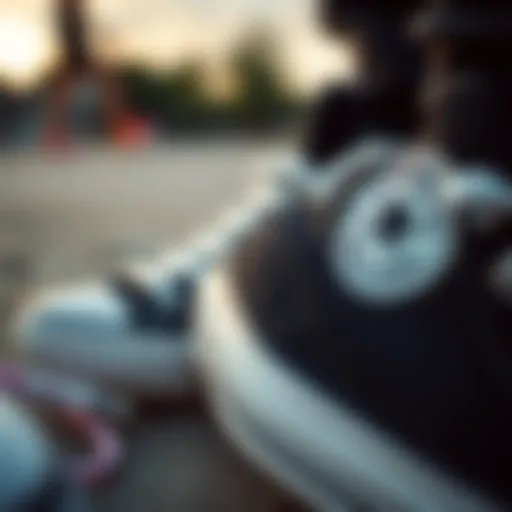Comprehensive Guide to Tech Deck Parts and Their Roles


Intro
Tech Decks represent more than just a miniature version of skateboarding. They encompass a world where precision, creativity, and skill intertwine, offering enthusiasts an opportunity to express themselves through intricate tricks and styles, all scaled down to the tips of their fingers. As we delve into the various parts of Tech Decks, we will unveil how each component plays a critical role in the overall fingerboarding experience. By understanding these individual pieces—from the deck itself to the wheels—we can appreciate how they contribute to performance and enjoyment alike.
The significance of knowing the parts cannot be overstated, especially for newcomers trying to navigate this vibrant subculture. Familiarity with the equipment leads to improved technique, better maintenance, and ultimately a more rewarding fingerboarding journey. As we progress through this guide, we will cover the functionality of each part, the impact of materials, and ingenious configurations that may elevate your gameplay.
Tricks and Techniques
Mastering tricks in fingerboarding hinges on a thorough knowledge of your Tech Deck’s components. Each part, from the trucks to the grip tape, plays a vital role in executing tricks successfully. Here, we’ll explore popular tricks and outline step-by-step guides to help both novices and seasoned skaters refine their techniques.
Step-by-step Guides to Popular Tricks
- Ollie
The foundational trick of fingerboarding, an ollie involves snapping the tail of the board while dragging a finger up toward the nose. - Kickflip
A twist on the ollie, the kickflip has you flipping the board sideways. - Heelflip
Essentially a kickflip but with a different flick angle, the heelspring allows for unique variations in style.
- Step 1: Position your finger on the tail and your other finger near the middle of the board.
- Step 2: Push down on the tail swiftly while dragging your other finger up the grip tape.
- Step 3: As the board lifts, level it out with your fingers so it lands smoothly.
- Step 1: Similar stance to the ollie. The back finger should stay on the tail, while the front finger is a tad farther toward the nose.
- Step 2: Execute the snap as you drag, but flick your front finger away from the board's edge to initiate the flip.
- Step 3: Keep an eye on the board's rotation, catching it with your fingers to land it effectively.
- Step 1: Position your fingers similar to the kickflip.
- Step 2: Perform the ollie but instead of flicking with the front finger’s toes, use the heel.
- Step 3: Catch the board once it has flipped and prepare for landing.
Common Mistakes and How to Avoid Them
Mistakes are part of the learning curve; however, understanding them helps skaters avoid pitfalls.
- Over-Snapping: Too much pressure during the snap can lead to an uneven ollie.
Tip: Practice controlling your pressure. - Poor Placement of Fingers: Having fingers too close to the edges can compromise stability.
Tip: Adjust your grip to maintain balance. - Not Watching the Board: Failing to follow your board with your eyes makes landing tricky.
Tip: Always keep your gaze on the board during tricks.
By refining your techniques, you'll not only perform tricks with finesse but also enjoy the aesthetics of fingerboarding more thoroughly.
Gear and Equipment
Reviews and Comparisons of Skateboards and Accessories
When it comes to enhancing your fingerboarding experience, the right gear makes a world of difference. Each component, whether it's a custom deck or premium wheels, plays a role in how well you can execute tricks. In the next section, we'll discuss various brands and models that provide options for both beginners and more experienced skaters, enabling you to make informed choices.
Essential Gear for Beginners and Advanced Skateboarders
To kickstart your fingerboarding adventure, having the right tools is key. Here's a list of essential gear for those just starting:
- Decks: Look for lightweight options that offer durability; brands like Tech Deck or Blackriver are great for starters.
- Wheels: Softer wheels provide better grip for beginners, while harder wheels are favored for tricks.
- Trucks: Consider the width of your deck; finding a proper fit enhances stability.
For advanced skaters, consider upgrading to customized decks and professional-grade wheels to tailor performance to your style.
"The right setup doesn’t just improve performance; it excites the spirit of skateboarding itself."
By prioritizing the right gear and understanding the tricks, you can elevate your fingerboarding journey, ensuring each session is filled with both learning and pleasure.
Understanding Tech Decks
Tech Decks are more than just miniature skateboards; they are a bridge to a unique culture and community centered around the art of fingerboarding. Understanding Tech Decks allows enthusiasts to fully appreciate the intricacies involved in candidly navigating this tiny version of a colossal sport. In this article, we seek to illuminate several key components that contribute to the effectiveness and enjoyment of Tech Decks. Notably, the material selection, deck design, and accessorization all come into play when creating a personal connection with this skill transcending simple play.
The experience of fingerboarding doesn't merely hinge upon one's dexterity. It boils down to recognizing how each part influences performance and engagement. More than just a toy, Tech Decks evoke a sense of nostalgia. They remind us of our youthful explorations, as well as our penchant for creativity. The fundamentals are also crucial for newcomers seeking proficiency swiftly, and for seasoned skaters wishing to unlock new tricks.
Origin and Evolution
The keepsake of Tech Decks dates back to the late 1990s when skateboard enthusiasts desired a new outlet to replicate their moves in a miniature form. Initially designed to resemble the actual skateboards, they gained traction amongst the youth culture that celebrated skateboarding as more than just a hobby—it became an identity. Many who found themselves engrossed in the punk rock aesthetics and rebellious ethos of skateboarding discovered that Tech Decks could provide an accessible and fun way to engage with that world, regardless of their physical space.
Over the years, Tech Decks have evolved in design and functionality. With improvements in materials and engineering, they now offer realistic features that cater to both novices and adept fingerboarders. Skate park designs, logos, and graphics have grown and diversified. As a result, customization became part of the allure, further laying the groundwork for a burgeoning community of passionate fingerboarding enthusiasts. Those wishing to dive into the origins can explore related forums that unpack the cultural significance of these diminutive boards—a tapestry of shared experiences woven through countless sessions.
Popularity in Fingerboarding
The widespread popularity of Tech Decks reflects their relatability to both the skateboard culture and the larger society. In playgrounds, coffee shops, or even classrooms, these fingerboards have engrossed audience with mesmerizing tricks and intricate maneuvers. Many young users found gratification in their ability to perform tricks in tight spaces without the constraints that a full-size skateboard imposes.
The rise of social media further catapulted Tech Decks into the limelight, showcasing the creativity and skills of fingerboarders. Videos showcasing elaborate tricks have become popular on platforms like Instagram and TikTok, drawing in a new wave of followers who are eager to learn. Hashtags like #TechDeck and #Fingerboarding have created virtual communities where enthusiasts share tricks, tips, and even modifications.
This community does not shy away from creativity; it embraces the evolution, resulting in inspired designs and unique techniques that perpetuate the growth of fingerboarding culture.
In light of the aforementioned trends, Tech Decks continue to stand as an emblematic representation of youth culture. They successfully blend nostalgia with contemporary digital influences, creating a lasting legacy that maintains momentum. As new generations pick up fingerboarding, it becomes evident: the world of Tech Decks is here to stay.
The Deck
The deck is perhaps the most essential part of a Tech Deck, as it serves as the platform on which all tricks and maneuvers are executed. Understanding the nuances of the deck is crucial for fingerboarding enthusiasts, whether they're just starting out or are seasoned pros looking to upgrade their set. The deck’s material, design, and overall construction can profoundly influence performance, making this section particularly significant in comprehending how these components contribute to the fingerboarding experience.
Material Considerations
Plastic vs. Wood
When it comes to material choices for Tech Decks, plastic and wood are the two primary options, each bringing their own flair to the table.
Plastic decks tend to be lighter and more affordable, making them a popular choice for beginners who may not want to make a significant investment right off the bat. Their build allows for some resilience against wear and tear during those inevitable drops. However, a drawback is that they might lack the authentic feel of a high-quality wooden deck, which can compromise the trick execution for more seasoned users.
On the other hand, wood decks, typically crafted from layers of maple, offer a superior grip and tactile feedback that can only be appreciated after some practice. The authenticity of performance can take a bit of getting used to, but the dramatic increase in control and maneuverability is undeniable. The downside is that wood decks can be pricier and might chip or splinter over time, especially during high-impact tricks.
Durability and Flexibility
Durability and flexibility are key attributes to consider for a Tech Deck’s performance. A more durable deck can withstand the scrapes and bumps that come with prolonged use. Plastic decks usually score high on the durability scale, but they might not have the same level of flexibility. Some riders appreciate a bit of give during tricks, which wood decks typically offer due to their layered structure.


This flexibility allows for better shock absorption landing tricks, making it easier to nail those elusive moves. However, this can sometimes come at the cost of sturdiness, especially during heavy usage.
Shape and Design
Concave vs. Flat
The shape of a Tech Deck plays a critical role in how tricks are executed. Concave decks have a raised middle section that enables skaters to lock in their feet better during flips and grinds. This shape offers enhanced control over tricks and can give skaters a confidence boost when trying new maneuvers.
On the flip side, flat decks offer a more stable base and are easier for beginners to learn on. They provide a simple, solid platform for executing basic tricks, but the lack of concave might limit advanced trick capabilities. Choosing the right shape often boils down to skill level and personal preference.
Graphic Aesthetics
The aesthetics of a Tech Deck are not just for show; graphic designs can communicate a skater’s personality and style. High-quality prints on wood decks usually last longer and can contribute to the overall look and feel of the setup. Bright graphics catch the eye and can often make a deck feel more premium. However, this aesthetic aspect serves a dual purpose; it can also distract from performance if not thoughtfully integrated.
Moreover, customization through stickers or paint can make any Tech Deck uniquely yours. Skaters often engage with this creative process, adding a layer of personal expression to their fingerboarding experience. However, it’s crucial to ensure that any additions do not compromise the deck’s performance.
"The deck is where it all begins; whether it's comfort, style, or performance, the right one makes a world of difference."
The Trucks
The trucks are one of the most integral components of a Tech Deck. They serve as the axles that connect the wheels and allow for essential movement. Understanding how the trucks function can greatly enhance a skater's experience and performance. When picking a Tech Deck, the choice of trucks can drastically change the feel and performance of your fingerboard.
Components of Trucks
Hangers
Hangers are pivotal to the functionality of the trucks. These metal arms hold the wheels in place and dictate how the Tech Deck turns. A key characteristic of hangers is their width—typically, wider hangers allow for a smoother turn, while narrower ones offer more stability during tricks. This can be a beneficial choice for those who favor control and precision over rapid maneuvers.
One unique feature of hangers is that they come in different heights. Tall hangers, for instance, can offer more clearance for larger wheels, which can be advantageous if you're into street skating, as it allows for easier navigating over obstacles. However, taller hangers can sometimes lead to a higher center of gravity, which some fingerboarders might find challenging when executing flips and spins.
Baseplates
Baseplates connect the hanger to the deck. Their design is crucial as it impacts the overall stability of the Tech Deck. A notable characteristic of baseplates is the mounting hole pattern; this affects how well it fits onto the deck. Most come standard with several adjustments available, aiding in customization and fit. This versatility makes baseplates a popular choice among skaters who tend to swap parts or work on different setups.
One unique aspect of baseplates is the ability to choose between a low or high profile design. Low profile baseplates keep the board closer to the ground, enhancing stability for flatland tricks. On the other hand, high profile options provide more room for tricks that require popping the board into the air. The downside here is that higher baseplates can make flipping tricks slightly harder due to increased leverage needed.
Types of Trucks
Standard Trucks
Standard trucks are what many skaters start with, as they offer a good balance between performance and price. They are designed to accommodate a wide range of styles and are generally reliable. The key characteristic of standard trucks is their uniform width, which ensures a consistent ride. This uniformity makes them a beneficial choice for newcomers who are just getting to grips with the complexities of fingerboarding.
One unique feature of standard trucks is their durability. Made from sturdy materials, they withstand the wear and tear that comes from trick execution. However, they might not be as agile as specialty models designed for specific tricks, which could be a disadvantage for more advanced skaters looking for enhanced performance.
Custom Trucks
Custom trucks grant fingerboard enthusiasts the ability to tailor their setups to their precise preferences. These trucks often feature unique designs and materials, allowing for a personal touch that standard models cannot provide. A significant quality of custom trucks is versatility; they can be fine-tuned for specific styles, whether that’s street, vert, or freestyle. This adaptability makes them a popular choice for skaters who want to express their individuality.
However, the unique features of custom trucks can also come with disadvantages. They may require more maintenance due to the intricacies involved in their setup. Additionally, they tend to be more expensive, so it might not be an option for casual users trying the hobby for the first time.
The nuanced differences between standard and custom trucks play a significant role in fingerboarding. A skater’s choice can determine not just the aesthetic of their setup, but also the performance and feel of their tricks.
"Understanding your Tech Deck’s trucks can drastically alter your fingerboarding experience; it’s worth investing time to find what best suits your style."
For further reading and community discussions, consider visiting forums like Reddit and exploring various user experiences in dedicated Tech Deck groups on platforms like Facebook.
Wheels
Wheels are not just an accessory on a Tech Deck; they play a vital role in determining how smooth and responsive the ride feels. The right set of wheels can make the difference between a lackluster performance and an exhilarating experience. From the material choices to the size, every aspect of the wheels impacts the fingerboarding experience, making them an essential component to consider.
Material Choices
Urethane vs. Plastic
When it comes to wheels, the material is a game changer. Urethane and plastic are the two primary options available. Urethane wheels are often favored for their superior grip and smoother ride. This material is known for its resilience; it's tough, enduring heavy impacts while maintaining its form. On the flip side, plastic wheels are typically cheaper and might be attractive for newcomers or casual users who are just dipping their toes into fingerboarding. However, they don't perform as well on rough surfaces, and they tend to wear out faster.
- Key Characteristic: Urethane wheels grip better and provide a smoother glide, making tricks feel effortless.
- Unique Feature: Urethane’s elasticity allows for a better shock absorption.
- Advantages: Better performance on various surfaces, durability over time.
- Disadvantages: Higher price point compared to plastic options.
Choosing urethane is often seen as a rite of passage for serious fingerboarders, bringing a noticeable edge in performance.
Grip and Slide
The grip and slide of the wheels is another crucial consideration. Good wheels should balance grip and slide to allow for tricks while ensuring stability. Wheels that grip too much can hinder sliding techniques like grinds and slides, while those that are too slick can make executing certain moves a challenge. This nuanced balance is what makes or breaks a session.
- Key Characteristic: A well-balanced wheel can aid in executing tricks efficiently.
- Unique Feature: Manufacturers often design wheels with a specific durometer, which affects both grip and slide.
- Advantages: Tailoring your wheels with the right grip enhances performance on different surfaces.
- Disadvantages: It can take time and experimentation to find the right mix for personal preferences.
Getting this balance right is key to improving skills and enjoying the fingerboarding journey.
Wheel Diameter
Performance Implications
Diameter affects how wheels perform in various environments. Smaller wheels generally offer more control, making them ideal for technical tricks. Conversely, larger wheels provide a smoother roll over rough surfaces, making them better suited for cruising.
- Key Characteristic: Wheel diameter can influence both speed and control.
- Unique Feature: Different diameters are designed for specific styles and preferences.
- Advantages: Understanding your style can help you choose the right diameter for optimal performance.
- Disadvantages: Some might struggle to adapt to a new size if switching.
Making the right diameter selection is about aligning the wheels with your personal riding style and preferred terrain.
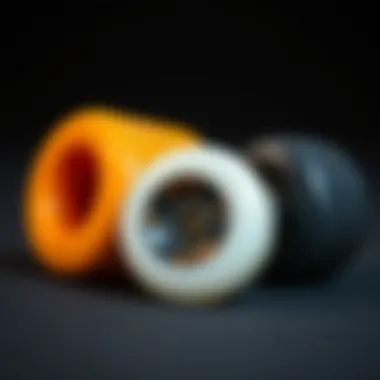
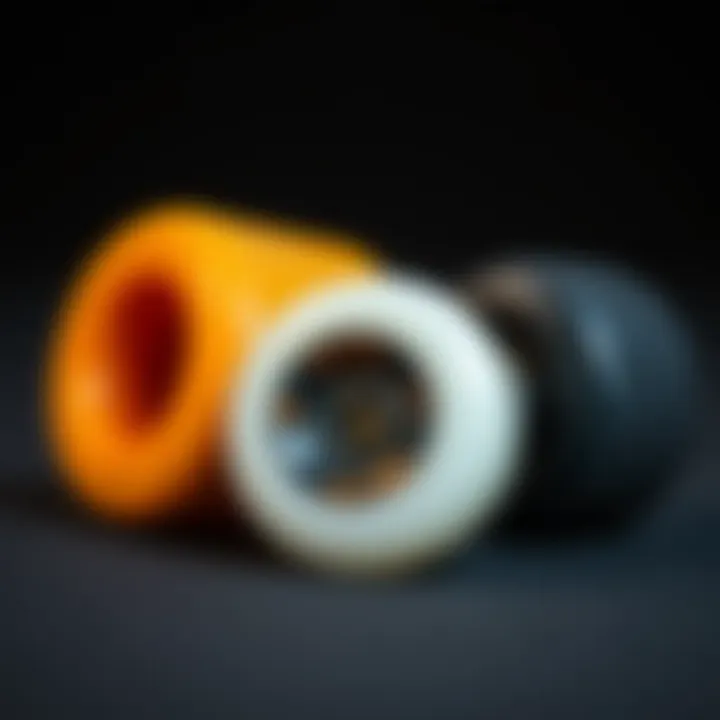
Choosing the Right Size
Selecting the right wheel size can initially feel like trying to find a needle in a haystack. Factors to consider include personal style and the types of tricks you plan to master. Generally, a diameter between 32mm and 38mm is popular for most fingerboarders, with the former lending itself well to tech tricks and the latter providing a bit more speed.
- Key Characteristic: The size influences how tricks feel and how responsive the board is.
- Unique Feature: Different activities may favor different sizes; for instance, street styles often lean towards smaller wheels for control.
- Advantages: The right size can enhance performance dramatically.
- Disadvantages: There’s a learning curve in adjusting to new sizes.
To find the perfect fit, you might have to try out a few different sizes. It’s all part of the process, figuring out what feels right under your fingers.
Final note: Whether you're cruising or hitting tricks, wheel choices shape the fingerboarding experience immensely. It's worthwhile to really consider how you want your board to perform and then make the right selections accordingly.
Grip Tape
Grip tape might seem like a simple add-on, but it plays a crucial role in fingerboarding. This essential component provides the necessary friction between your fingers and the board, allowing for control during tricks and flips. A good grip tape enhances not only performance but also the overall experience of fingerboarding, ensuring that you can execute moves with precision and confidence.
Types of Grip Tape
Standard Grip
Standard grip tape is the bread and butter of fingerboarding. Its gritty surface ensures that your fingers stick to it, preventing slippage while doing tricks. One key characteristic of standard grip tape is its universal fit; it works well with most board shapes and sizes, making it a go-to choice for many enthusiasts.
The main advantage of standard grip is its reliability. When you’re mid-air executing a kickflip, the last thing you want is your fingers slipping off the board. However, if you're looking for flair, it can be a bit plain compared to customized options, which may be a downside for some skaters.
Custom Designs
For those who wish to express their individuality, custom grip tape is the perfect way to stand out in the crowd. Custom designs can showcase unique graphics or colors, giving a personal touch to your Tech Deck. The characteristic of custom designs is that they offer a blend of functionality and aesthetics, allowing skaters to make a statement while maintaining grip.
One unique feature of custom grip tape is its potential for personal storytelling. Whether it's your favorite comic book character or a vibrant piece of art, these designs allow you to showcase your personality while engaging in the sport. However, one downside could be that some custom grip tapes may not provide the same level of traction as standard options, depending on the material.
Application Techniques
Proper Adherence
The way you apply grip tape can make or break your fingerboarding experience. Proper adherence ensures that the tape sticks well to the deck, preventing any lifting or peeling during use. The key characteristic of adherence lies in surface preparation—cleaning the deck thoroughly before applying the grip tape is essential for a long-lasting bond.
Laying down the tape correctly means smooth sailing through your tricks. If the grip tape starts to come off, it can lead to frustrating interruptions. While it may take a bit more time initially to ensure proper adherence, the payoff is worth it for a seamless fingerboarding experience.
Maintenance Tips
Just like any other part of your Tech Deck, grip tape requires some care to maintain its effectiveness. Regular upkeep can involve scraping off dirt or debris build-up, which can reduce the grip's effectiveness. One key characteristic of good maintenance habits is that they extend the life of the grip tape, saving you the hassle and expense of frequent replacements.
A simple cleaning routine can prevent slippage issues, providing a consistent grip for all your tricks. However, it's worth noting that excessive wear may eventually lead to needing a replacement. Keeping an eye on your grip tape and addressing maintenance proactively can save you from those annoying surprises when you go to practice.
Remember: A well-maintained grip tape is crucial for optimal performance, and it’s a small investment for the confidence you gain in your rides.
For more resources on customization techniques and maintenance, consider checking the following links:
Wikipedia on Fingerboarding
Community Discussions on Reddit
Expert Tips on Maintenance
Accessories and Add-ons
Accessories and add-ons play a critical role in personalizing and optimizing Tech Deck setups. While many skaters might focus solely on the core components like decks and trucks, enhancing performance and aesthetics through these additional parts makes a significant difference. From performance enhancers to customizable aesthetics, the right accessories not only elevate the visual appeal of a Tech Deck but also ensure it performs to its fullest potential.
Performance Enhancers
Bushings
Bushings, though small, pack a punch when it comes to performance. These rubber or urethane pieces fit inside skateboard trucks and significantly affect how the board responds during tricks. The key characteristic of bushings is their ability to compress, allowing for smoother turns and grinds, which provides better control and stability. Many skaters find softer bushings give them more flexibility, while harder bushings offer increased response, making them a popular choice among enthusiasts.
When it comes to uniqueness, some bushings are designed with various durometers, providing options tailored to personal skating styles. The advantages of choosing the right bushings are substantial; they can vastly improve turning radius and make the board feel more alive underfoot. However, it’s important to note that aggressive setups with extremely hard bushings can sometimes lead to a bumpy ride, particularly for those just starting.
Shock Pads
Shock pads, often overlooked, can greatly benefit your Tech Deck experience. These pads are typically made from materials like rubber or foam and are placed between the trucks and the deck. Their primary function is to absorb impact during landings, reducing strain on the deck and providing a smoother ride. The key characteristic of shock pads is their ability to cushion impacts, which makes them an attractive choice for skaters looking to enhance durability.
Shock pads offer unique advantages as well. They help protect the deck from fractures and warping, prolonging its lifespan. On the downside, adding shock pads can slightly raise the height of the board, which might not appeal to every rider, especially those favoring technical tricks where a lower center of gravity is essential.
Customizable Aesthetics
Stickers and Decals
Stickers and decals offer skaters a fun platform for self-expression. These little bits of creativity can change the entire look of a Tech Deck. One of the major appeals of stickers is the nearly limitless number of designs available, from bold graphics to detailed art, allowing skaters to showcase their personality. The ease of application makes them a favored choice for many, enabling quick updates to a board's look.
Unique features like waterproof materials and die-cut shapes can elevate the quality and appeal of stickers. However, one disadvantage might be the potential for stickers to peel over time, especially with heavy usage. Still, the ability to swap them with the seasons or moods is a large draw for many within the community.
Paint Options
When it comes to customizing a Tech Deck, paint options provide another artistic outlet. Custom paint jobs can transform a basic model into a one-of-a-kind masterpiece. The key characteristic here is the versatility offered by spray paints or acrylics, allowing for intricate designs, color gradients, or even detailed illustrations. Custom paint is especially appealing for those who want to make a strong personal statement through their setup.
The richness in color and texture can create a board that grabs attention. Nonetheless, applying paint does require precision and skill to avoid messiness. Moreover, the paint can wear off with use, necessitating maintenance to keep the appearance fresh. Finding a balance between aesthetic appeal and durability is critical when working with paint options.
Customizing your Tech Deck isn’t just about looks; it reflects your identity and how you approach the art of fingerboarding.
For more in-depth discussions about Tech Deck customizations and performance enhancements, you might consider visiting forums on Reddit or browsing resources like Wikipedia.
Maintenance of Tech Deck Parts
Maintaining Tech Deck parts properly can dramatically affect the performance and lifespan of your setup, providing a smoother fingerboarding experience. As with any customized hobby, treating your equipment with care not only enhances its appearance but also its functionality. Regular upkeep can prevent problems before they arise, saving you from costly replacements or frustrating performance issues down the road.
Regular Cleaning
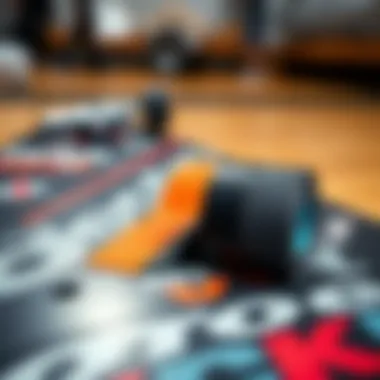
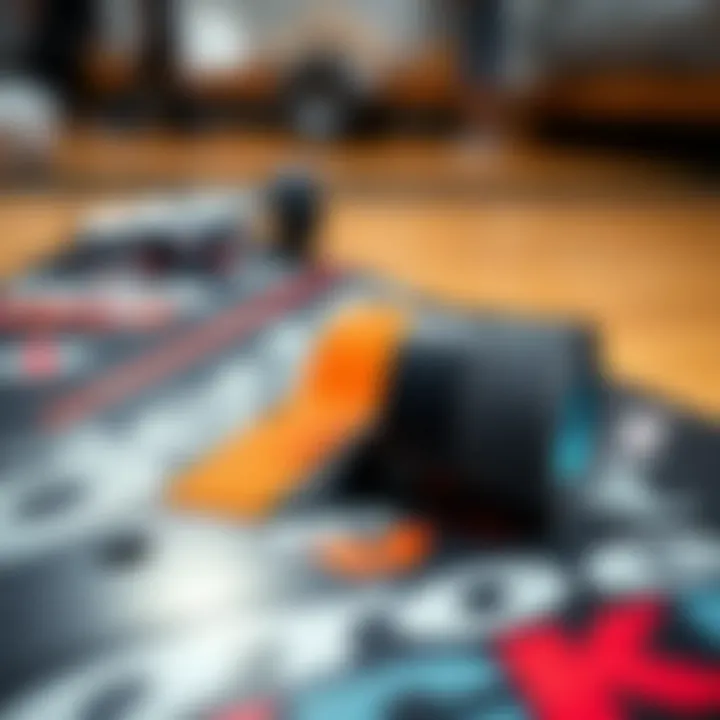
Cleaning is often overlooked, but keeping your Tech Deck tidy is crucial. Dust, dirt, and debris can build up, impacting how well the parts interact. A clean setup will perform better and can also look quite appealing.
Cleaning Tools
When it comes to keeping things spick and span, having the right cleaning tools makes all the difference. Common items include soft brushes, microfiber cloths, and even cotton swabs. The softness of these tools is their key characteristic; they can get into those nooks and crannies without risking damage to delicate parts.
Having a proper brush set, for instance, is a beneficial choice for enthusiasts. The soft bristles can effectively remove grime without scratching the surface of your deck or trucks. However, one downside could be the need for regular replacement due to wear and tear. Here are some notable cleaning tools:
- Microfiber Cloth: Excellent for wiping down surfaces without leaving lint.
- Soft Brush: Great for removing dust from grip tape and wheels.
- Cotton Swabs: Perfect for tighter spaces and intricate designs.
The unique feature of using microfiber is its ability to trap particles more efficiently than regular cloth.
Pest Removal
Strange as it may sound, pests can become an issue for your Tech Deck, particularly if you store them in humid or heavily populated areas. Finding gnats or tiny bugs stuck in your setup can be disheartening. Pest removal is essential, as these little creatures can damage the quality of your materials.
The best approach is prevention; keeping your Tech Deck stored in a clean, dry place mitigates this problem significantly. A simple and effective solution is to use sticky traps placed around your skateboard gear. The beauty of these traps is in their effectiveness and simplicity.
However, a downside can come from improper usage, which might result in the traps sticking to your parts, causing potential damage.
Replacement Considerations
Eventually, parts will wear out or become outdated by new innovations or personal preferences. Knowing when and how to replace elements can keep your Tech Deck at its peak performance and avoid unnecessary frustration.
When to Replace Parts
Identifying the right time to replace parts is one of the crucial aspects of maintenance. There’s a fine line between keeping things functional and pushing them to the limits. Signs you might need to replace a part include visible wear, unusual noises during use, and performance dips. For instance, if trucks make squeaky sounds when turning or if wheels start feeling sticky, that could be the indicator it’s time for new ones.
The characteristic trait of knowing when to replace parts lies in the ability to recognize performance issues. Replacing components, like wheels or grip tape, can give new life to the setup. However, the downside is that it often comes at a cost, both financially and in the effort needed to reassemble everything.
Compatibility Issues
It can be quite frustrating to purchase new components only to find they don’t match or fit your current setup. Compatibility issues often arise with different brands or models. When considering a replacement, it’s critical to check if the new parts will work well with existing hardware. Unfortunately, not all items are created equal.
The key characteristic of compatibility issues is that they may limit your choices while customizing a Tech Deck. It’s usually a beneficial practice to ensure that new trucks align with your deck's specifications. However, doing your research ahead of time can prevent headache down the line, as mismatched components could lead to unforeseen issues during performance. Always consult the manufacturer’s guidelines or community forums to avoid mix-ups.
Custom Tech Decks
Personalizing your Tech Deck not only enhances the aesthetics, but it also allows skaters to create a board that resonates with their individual style and preferences. Custom Tech Decks stand as a testament to creativity in the fingerboarding community, where each board can reflect unique imaginations and ideas. Moving beyond simply being a toy, a personalized Tech Deck embodies the spirit of the skater who wields it.
Benefits of Customization
When it comes to customizing Tech Decks, the benefits are numerous. Here are a few key advantages:
- Unique Identity: Customization enables skaters to express who they are. Whether through colors, graphics, or components, each skater can make their Tech Deck truly their own. This individuality fosters a deeper connection to the board.
- Optimized Performance: Adjusting various elements like wheel hardness or truck width can significantly affect performance. A custom setup allows skaters to fine-tune their board based on their style of tricks or terrain preferences.
- Increased Enjoyment: The act of modifying a Tech Deck adds a layer of satisfaction. Creating and implementing a personal design can be as rewarding as performing tricks. The sense of ownership boosts overall enjoyment during practice or competition.
"Customization of Tech Decks brings the thrill of skating to a whole new level—it's about more than just tricks, it's about personal expression."
Popular Customization Trends
A wave of creativity has washed over the Tech Deck scene. Skaters are constantly finding new ways to make their boards stand out. Here are a few popular trends:
- Artistic Decks: Hand-painted designs and custom graphics have become trends. Artists within the fingerboarding community often showcase their talents, creating limited-edition boards that are highly sought after.
- Unique Wheel Choices: Different wheel types can dramatically change how a board feels. Some skaters choose softer urethane wheels for a smoother roll, while others prefer harder wheels for sharper tricks.
- Themed Sets: From superhero motifs to retro designs, themed decks are capturing attention. These sets often include matching accessory items, such as grip tape or complementary stickers, enriching the overall skateboard aesthetic.
- Material Upgrades: Using alternative materials for decks or trucks can enhance durability and performance. Skaters frequently experiment with bamboo or composite materials which offer different flex patterns and weights.
Custom Tech Decks are not just a trend; they have become an integral part of the fingerboarding culture, allowing practitioners to showcase their artistry and innovation.
Tech Deck Community and Culture
Understanding the Tech Deck community and culture is crucial in appreciating the skipped beats and fervor surrounding fingerboarding. This subculture is not just about the decks themselves; it’s an ecosystem fueled by passion, creativity, and connection. With forums buzzing with discussions and events rallying enthusiasts, it is a domain where skills are honed, and friendships are made. The significance of community engagement cannot be overstated, as it offers a vibrant backdrop against which novelty and innovation thrive. Being a part of this community not only enriches one's skills but also fosters an environment where individuals can share experiences and tips, forming a tight-knit family that binds skaters together.
Online Forums and Discussions
Online forums serve as the beating heart of the Tech Deck community. Platforms like Reddit and dedicated fingerboarding websites brim with discourse ranging from beginner tips to advanced tricks. These forums allow users to post videos, ask specific questions, and obtain feedback on their techniques. They also enable an exchange of ideas on customizing decks, trucks, and more. Users share tutorials and showcase their custom creations, making it a treasure trove for aspiring and seasoned skaters alike.
Some notable elements of online forums include:
- Skill Development: Newbies can ask for guidance, while veterans offer tips and advice on perfecting tricks.
- Customization: Participants share photos and techniques on how to personalize their boards, celebrating creativity.
- Networking: Members connect with others who share a common interest, sometimes leading to real-life friendships.
Diving into these online spaces often feels like eavesdropping on the coolest skate sessions happening right in one’s living room. The collective enthusiasm is palpable, invigorating more than just individual skills but also a shared love for fingerboarding as an art form.
Competitions and Events
Competitions and events are the sidelines of the Tech Deck arena, showcasing not only skill but also camaraderie. If online discussions are the lifeblood, these competitions are the thriving heart, accentuating the excitement that fingerboarding brings. Events can be a local showdown in a skatepark or larger contests drawing in participants from various regions, often culminating in community gatherings where knowledge is not just shared but celebrated.
Key aspects of competitions include:
- Skill Showcase: Participants use these events to impress judges and onlookers with their finest tricks and techniques.
- Community Spirit: Events bring together enthusiasts from diverse backgrounds, celebrating the artistry and effort that goes into fingerboarding.
- Inspiration and Motivation: Watching others perform can motivate skaters to push their own skills further, fostering growth across the community.
"These competitions don’t just test abilities; they remind us that we’re part of something more significant. It’s a place to learn, grow, and share."
— Anonymous Fingerboarding Enthusiast
Epilogue
In any conversation about Tech Decks, it makes sense to land on the conclusion, which ties together all the fascinating components and elements discussed throughout the guide. Each part, from the deck itself to the finer details like the grip tape and wheels, plays a crucial role in how a Tech Deck performs and feels in your hands. When you grasp the significance of each element, it allows you to make better choices, whether you're a seasoned pro or just starting out.
Final Thoughts
As we've explored in this guide, every inch of a Tech Deck contributes to the joy of fingerboarding. The materials chosen for the deck impact its durability, while the design informs how it interacts with the trucks and wheels. Furthermore, understanding how various parts crave attention in terms of maintenance or customization can elevate the overall experience. Think about it—having a grip tape that fits your hand's vibe or wheels that accommodate your performance style makes every ollying over a tabletop all the more rewarding.
“A well-tuned deck can turn an ordinary session into an exhilarating thrill ride.”
Further Exploration
To most effectively enhance your fingerboarding journey, consider diving deeper into various communities dedicated to Tech Deck enthusiasts. Platforms like Reddit or Facebook often hold discussions and showcase innovations in the world of Tech Decks. Moreover, checking out videos on YouTube can provide visual aids into tricks and techniques that are both inspiring and informative. For those keen on more academic approaches, visit educational resources such as Britannica for insights into the physics of skateboarding and fingerboarding. All of these insights can foster not just knowledge but camaraderie among fellow skaters. In the end, immersing yourself in this vibrant culture can lead to a richer, more fulfilling experience with your Tech Deck.











